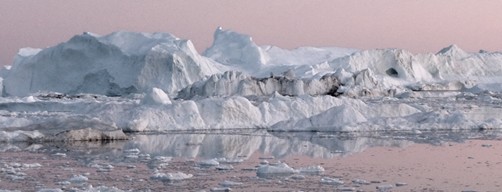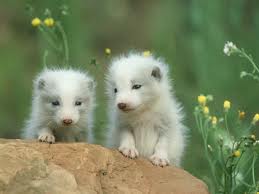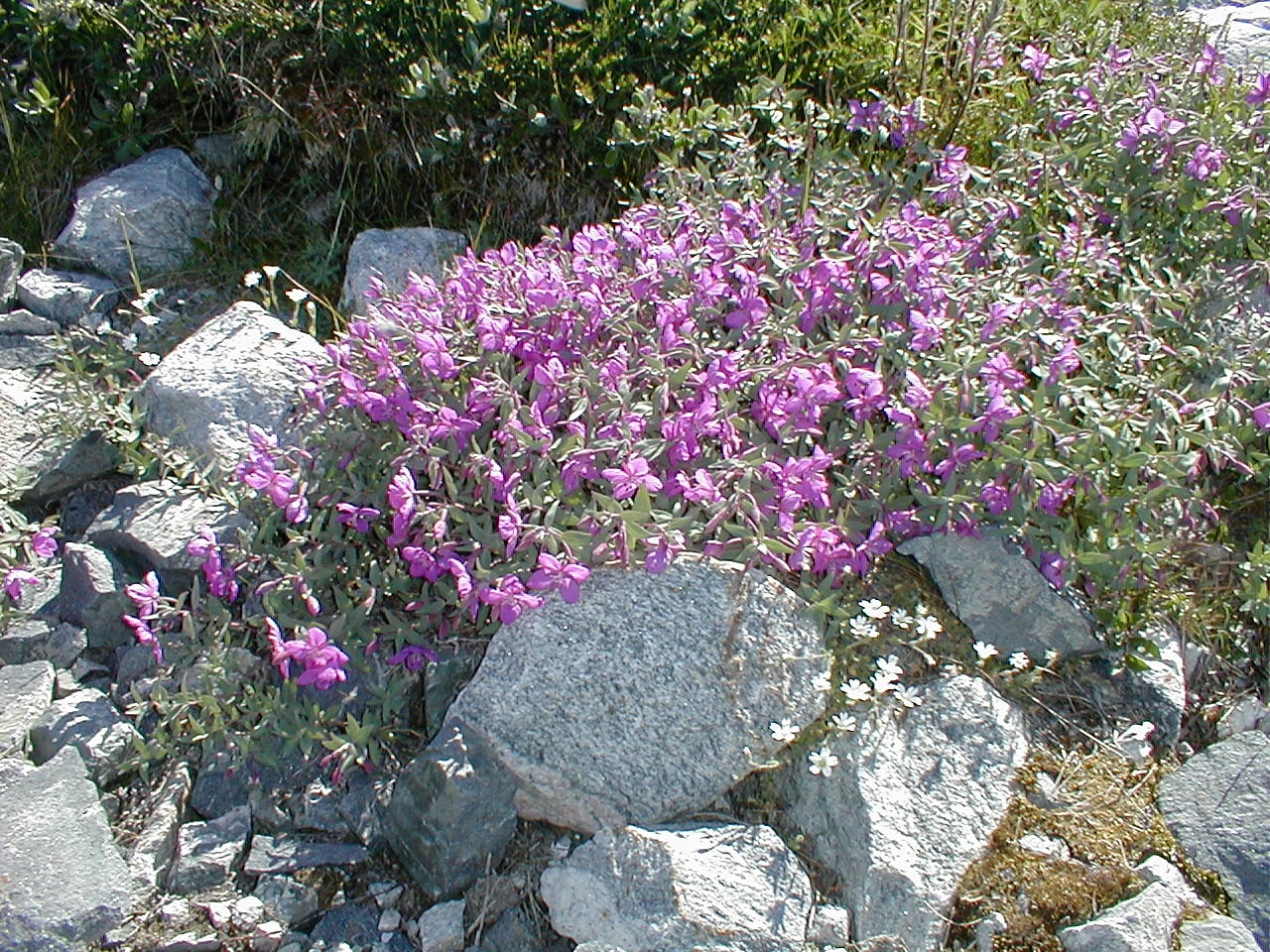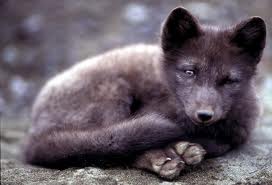Arctic Fox
Alopex Lagopus, order Carnivora, family Canidae.
The arctic fox lives in an extremely cold environment and has been described as one of the most highly adapted arctic animals. Adaptions to the cold include a long dense winter pelt and short legs, ears and muzzle. Arctic foxes are extremely cold-tolerant as a result of the insulative quality of their winter fur, and they have a lower critical temperature in
excess of - 40 C.
Arctic foxes stand 25-30 cm at the shoulder and have average body lengths of 52-70 cm and tail length of 23-34 cm. Normal body weights vary from 2.5 to 5.0 kg. Females are slightly smaller than males.
There are two colour phases of the arctic fox, white and blue. Colour is determined by a single gene locus; homozygous recessive individuals are white, whereas those with dominant alleles are blue. Both colour phases are present in most populations and interbreed freely. The proportion of each colour phase varies widely from one geographic area to the next.
The majority of arctic foxes start breeding in their second season, although they become sexually mature at 9 month. Arctic foxes begin to form pairs and seek den sites during february and march, and most pairs are established no later than early may. They are monoestrous and most mating occurs in march and april. Litters are usually born in may or june after a gestation period of 51-52 days. Litter sizes vary widely from one geographic area to the next, they also vary annually. Litter sizes normally ranges from 3 to 9, but litter
sizes over 10 has been recorded several times. Reproduction performance depends heavily on available food sources in late winter and early spring. Some years no pups are raised at all owing to food shortages in this period.
Only 10 % of young foxes survive their first year due to cannibalism, starvation and diseases such as rabies, distemper and parasites.
Extensive studies has clearly demonstrated that the arctic fox is carnivous and an oppor-tunistic foorager, acting as both predator and scavenger and utilizing any food source available. Predictably, this oppotunistic feeding strategy results in wide seasonal and regional variation in diet composition.
Arctic foxes are known to be capable of extensive movements either by themselves or drifting in the pack ice following and scavenging on remnants from the polar bear. Infrequently large numbers of arctic foxes travel in a sustained direction, giving their movements the appearence of a migration and sometimes leading them far out of the arctic region.
Ilulissat 05-11-2001
Embedsdyrlæge Ken Leisner
Brief history of rabies in Greenland
1859 Upernavik district, reports of epizootic paralytic rabies among the sleddogs.
1866 First veterinary description of the disease among the sleddogs followed by the first rabies legislation for the Danish Colonies in Greenland.
1875 Upernavik district, reports of rabies canina furiosa epizootica following the visit of the American Nares "Discovery" expedition in 1874, several attacks on humans by sleddogs.
1889 Ban on any import of dogs to the Sleddog Districts in Greenland. To protect the Indigenous Inuit Sleddog in Greenland this ban is still effective today.
1905 Aasiaat district, the Danish veterinary Hjortlund inoculate material from dogs dead with typical symptoms of rabies into rabbits and back again on puppies and in this way establish the infectious character of the disease.
1906 Ilulissat district, Hjortlund recognizes the arctic fox as the reservoir and vector of rabies in Greenland and realizes the enzootic nature of the disease.
1908 As the result of the work done by Hjortlund new and updated legislation on rabies is instituted. This legislation from 1908 is still the foundation for the present rabies legislation in Greenland today.
1959 Well assisted by US Airforce on Thule Airbase the Danish veterinary Wamberg gets material from suspected rabies cases to a labratory in USA. Rabies virus is found by the immunofluorescence method in two arctic foxes and two sleddogs. Rabies is then officially recognizied as being present and enzootic in Greenland.
1960 During a rabies epizootic in Aasiaat in which approximately 1000 sleddogs die of the infection a 4-year old girl is bitten by a sleddog and dies in hospital 4 month later. The rabies diagnosis on the girl is confirmed by laboratory tests.
1969 Mandatory vaccination of dogs against rabies and prohibiton against loose dogs are instituted in the legislation.
1975 Current monitoring of rabies is instituted, all suspected cases are examined by laboratory tests at the Danish Veterinary institut for Virus Research, Lindholm.
1979 Greenland is granted Home Rule from Denmark.
1992 In consequence of the Law of Home Rule the responsibilty of zoonosises is taken home to Greenland.
1993 The District Veterinary Office of Ilulissat is established supervising rabies and generel health care in the Greenland Sleddog Population.
Is altered incubation period as result of adaption between the Arctic Fox and Arctic Lyssa Virus the explanation of the enzootic appearance of rabies in the Arctic ?
Geographically Greenland is situated between Svalbard and Russia in the East and Northern Canada in the West.
Which strains of Arctic Lyssa Virus exists in Greenland, could the strains of virus indicate ecology and behavior of the Arctic Fox around the North Pole, and in that way help predicting rabies epizootics ?
Rabies and Distemper has a long history together in the Arctic. Both diseases affecting
the Arctic Fox and the Inuit Sleddog and both causeing epizootics, sometimes merging.
Does Distemper interact with rabies in the Arctic systematically or is it just coincidentically ?
Ilulissat 06-11-2001
Embedsdyrlæge Ken Leisner
Greenland
Northern Greenland is the most northerly situated territory in the world and the northern-most point in Greenland Kap Morris Jessup is situated only 700 km from the North Pole.
In the Thule district the summerday has a duration of nealy 5 month due to the midnight sun, and the winternight a similar duration of 5 month due to the disappearence of the sun.
The southernmost point in Greenland is situated on the same height as Stockholm and Oslo in Scandinavia, the westerly most situated point at same longitude as New York City, and the most easterly situated point at the same longitude as the westcoast of Ireland.
Thus Greenland is the worlds greatest island and stretches from north to south over 2.670 km and from east to west over 1.250 km.
The shortest circumsailing of Greenland would be approximately 7.000 km, but the real coastline is estimated to be around 40.000 km.
The ice free coastal areas are measured to be 383.600 km2 , against which the Inland Icecap is 1.802.000 km2 covering over 80 % of Greenland.
The Greenland Inland Icecap has an average thickness of 2135 m and are considered to hold 7 % of all fresh water on Earth. Influence of the Inland Icecap is present everywhere in Greenland and dominates climate and vegetation and thus wildlife and human behavior.
The Climate in Greenland is typical for the high arctic tundra, dessertlike with extensive permafrost and a thin coverage of soil - and therefore virtually treeless. The Sea, the Ice and the Climate gives an amfibibious way of living for both humans and wildlife - epitomized in the Polar Bear.
The human population of Greenland constitutes 56.000 people of whom 48.000 are inuit and 8.000 are europeans mostly coming from Denmark. The main city containing the central administration is Nuuk with 15.000 inhabitants. Greenland is divided into 18 municipalities, which because of the geography and difficult transportation opportunities have extensive obligations. The Inland Icecap is of course totally uninhabitated.
From the Polar Circle and northwards and on the Eastcoast is the Sleddog District of Greenland - the rest of Greenland is strictly non-Sleddog Territory.
2.800 inuit people are still registered as hunters and earn their living mainly from hunting seals, birds, caribou, muskox and occasionally polar bears. Approximately 800 hunters is still depending on sleddogs to hunt or fish in wintertime.
Fisheri for arctic shrimps, greenland halibut and crabs goes largely to export and are for the moment the chief income for the Greenland society.
In the very southernmost part of Greenland the climate is low arctic and enables each year approximately 60 farmers to raise 20.000 lambs on the ancient fields of the Norse settlements.
07-11-2001 Ilulissat
Embedsdyrlæge Ken Leisner
Ilulissat 06-11-2001
Embedsdyrlæge Ken Leisner
Puppies of the Arctic Fox
Historically there has been two reservoirs for rabies in Greenland - the urban reservoir in the Sleddog Population and the natural reservoir in the Arctic Fox Population.
As urban rabies is virtually eradicated in Greenland, how does rabies survive as an enzootic infection in a population so low in density as the Arctic Fox Population ?
Arctic Lyssa Virus infection is apparently displaying short incubation period and rapid mortality in members of the family Canidae.
How does rabies manage to stay enzootic in an area year after year without eradicating the Arctic Fox Population ?
The Arctic Lyssa Virus seems to be tenacious and survives well in dead animals in the Arctic Climate.
Is it possible that rabies in the Arctic has a third reservoir, that is animals which have died of a rabies infection and contains live rabies virus ?
Due to the vast areas in the Arctic and the low population density of the arctic fox it is impossible to eradicate rabies by vaccination, but experiments has shown that it is possible to vaccinate arctic foxes by using live attenuated rabies vaccine in dropped bait.
What is then the possibility of arctic foxes being infected by rabies virus by the oral route when scavenging on carcasses of animals dead by a rabies virus infection ?
From other Lyssa Virus/reservoir host interactions it is known that virus and host adapts to each other altering the incubation period.
Questions still to be asked and answered.











